Beaufoy Merlin
>> see also A. P-R. 1953
Reverse of one of Merlin's cartes shows the trademark of the American & Australasian Photographic Company's Sydney office in George Street. (51667)
Biographical records for the early life of Beaufoy Merlin are scant, but for his later years we have brief personal references in his press articles, and we have a revealing portrait taken in the Hill End studio perhaps a year before his death.
It shows a sensitive, artistic face, yet one not lacking in purpose. Above all, we have his life's work, or rather a substantial portion of it. The images carried on thousands of collodion negatives indicate that Merlin was a photographer who combined excellence in a difficult technique with an admirable flair for grouping and posing.
For many of his competitors along the country roads, the camera was mainly a means of making a living. Merlin's camera was used commercially but his unique artistic outlook separated him from most of his colleagues. His talents extended to the field of journalism, as will be seen from the number of excellent articles Merlin wrote for the Australian Town and Country journal, most of which were accompanied by large engravings based on his photographs, as noted in the Bibliography. |
|
Henry Beaufoy Merlin; portrait taken in the American & Australasian Photographic Company's studios at Hill End in 1872. (Portrait file)
Henry Beaufoy Merlin was born in 1830, the son of an English chemist, Frederick Merlin, and his wife Ann Harriet, and he was about nineteen years of age at the time of his arrival in Australia.
Of his early manhood little is known,1 but it could be suggested that his interest in photography arose from the family association with chemical science. In those days most large chemists stocked photographic outfits, whilst the perfection of the new wet-plate process attracted the attention of everyone with any scientific or artistic pretensions.
By 1866, Merlin had established himself in Victoria as a field or travelling photographer, working under the trade-name of the American & Australasian Photographic Company; however there is no evidence of association with America, or with areas other than Victoria and New South Wales. |
|
On his travels through Victoria, he made numerous records of the scenery but his energies were principally devoted to his house-by-house (and shop-by-shop) coverage.
The regular procedure was to give a few days' notice to the various householders in order that they might be ready for the camera, suitably attired in their 'Sunday-best'. These pictures - unlike the family souvenir snapshot or colour slide of today - were purchased at little over one shilling each for a definite purpose, to present, to faraway friends and distant branches of the family, undeniable proof that a degree of success, by virtue of land or home ownership, had been achieved in the new country.
There is still in the possession of the Merlin family an informative document relating to these Victorian trips. In accordance with a recognized custom of professional photographers of the period, Merlin had presented the Governor of Victoria, the Right Honourable Sir John Henry Manners-Sutton, with an album of photographs;2 in return, he received a letter of acknowledgement, one which was no perfunctory reply, but an expression of genuine appreciation, showing that Merlin was well established as a landscape photographer and that he had informed His Excellency of his plans to extend his activities to the other parts of Australia.
Government Offices,
Melbourne.
7 April 1869
Dear Sir,
I am directed to convey to you the thanks of His Excellency the Governor for the very handsome book of Photographs which you have presented to him, and which he especially values as containing so many interesting views of the places which he visited in his tour through the Western District last year.
The Governor desires me to request that you will let me know the name of your agent in Melbourne through whom His Excellency may be able to procure copies of the views which you propose to take in other parts of Australia.
Faithfully yours,
J. S. Rothwell, A.D.C.'
Some time in 1869 or 1870, in the company of a young but capable assistant, Charles Bayliss, whom he had personally trained, Merlin set forth for New South Wales and the wider fields of
opportunity he had so long envisaged. He could have had little inkling that, in the brief three years of life-span remaining to him his work in the new sphere would eventually establish him as, perhaps, one of the world's greatest documentary photographers of the collodion period.
From the evidence of existing photographs of places as far apart as Queanbeyan, Kiama and Maitland, it is clear that Merlin was working throughout the country areas of New South Wales during most of the period 1870-71.
The Sand's New South Wales Directory for 1871 lists the American & Australasian Photographic Company as being in business at 324 George Street and 399 Riley Street. Apart from this, there is pictorial evidence to show that during this period Merlin continued with his outdoor photography of Sydney. Of special interest is his 1870 photograph of the General Post Office which shows the George Street section of the building completed, the scaffolding having just been removed, while other photographs depict familiar Harbour scenes.
Towards the end of 1871 an unusual assignment came Merlin's way. When the New South Wales Government of the day required an official photographer for the Victorian-New South Wales Eclipse Expedition of 1871,3 Australia's first great enterprise in the field of astronomy, it did not hesitate to select Merlin for the position.
Merlin wrote a lengthy press report of the Expedition which appeared in the Australian Town and Country journal of 6 January 1872.
The site chosen for the observation of the total eclipse of the sun on 12 December 1871 was Cape Sidmouth in Northern Queensland, although later this was changed to an island in the Claremont Group. It was mid-summer and the temperatures were unexpectedly high. It was 14° degrees in the dark-room tent, and on every side there was glare from the dazzling coral strand.
No wonder that, on many occasions, Merlin's plates dried out before he could get them into their processing solutions:
`... we worked with unflagging zeal, notwithstanding the oppressive character of the climate, in preparing for the great event. There were eight or nine tents set up, the instruments in position, my own special appliances all arranged in order, and the whole party were on the qui vine for the long-anticipated moment of observing a solar eclipse, under circumstances calculated to do credit to the Australian colonies, and services to the cause of science.'
But rain-clouds obscured the eclipse for the whole of its totality, with the exception of a tantalizing second or two:
`There was just one instant's rent in the cloudy-mass, and we saw quite enough to know that contact had begun. The clouds closed again, and all was dark; but still there was palpably blended with the gloom the presence of another strange darkness.
In the direction of the sun, during totality, an arc of shadow, as if tinted in Indian ink, passed across a portion of the heaven evidently in line of the moon's course, and travelling at the moon's apparent rate of progress.
Every face bore as deep a shadow as Nature did.
We all realized, about the same moment, that we had come in vain ... To say we did not at once fully realize our disappointment, may be true; but we certainly, in the end, had a very adequate sense of it.'
Despite this grave disappointment, which was made the more bitter when it was discovered later that the clouds were quite local, Merlin turned his thoughts to the idea of achieving coastal surveys from the deck of the steamer on the voyage home. He tells us that his trial exposures 'succeeded in reproducing the elevations, depressions, projections, etc. with an accuracy impossible in hand-drawings'. He placed some `eminently practical results' before the Victorian Government - where apparently a suitable pigeon-hole awaited them.
Merlin returned to Sydney once more setting up his camera in front of suburban cottages, but the cry was again 'Gold', or more popularly 'Rush-O!'.
Some twenty years after those first eager rushes to the Ophir and the Turon in 1852, the tempo was again quickening all through the territory around the basin of the Macquarie River. And, further north, there was the new field of Gulgong, along the Cudgegong River out of Mudgee.
Photographers - like everyone else - had to follow the active centres of population and it is not surprising to learn that Merlin's coating caravan, presumably in the company of another vehicle for the staff and supplies, was soon on its way across the Blue Mountains.
It is not known whether his wife and young family accompanied him to Hill End or joined him there at a later date. The Hill End public school register shows that the three Merlin children, Mary (aged eight), Frederick (aged six) and Constance (aged three), attended the school during the period January to June 1873 when Beaufoy Merlin was covering the central west.
Beyond the railheads an efficient service was offered by the coaching companies; by changing horses every ten or fourteen miles, some fifty or sixty miles a day could be covered, according to the terrain. But for the private traveller or the teamster it was quite a different proposition.
Normally, he had but one set of animals and as these had to be properly cared for at intervals during the day and at night-fall, he was fortunate if he was able to maintain an average of about twenty miles a day. There was considerable expense involved, too.
Those who provided food and drink and accommodation for man and beast had to be reimbursed. Special services might be required as well, harness to be repaired, swingle-trees to be replaced and horse-shoes to be renailed.
Leaving Mt Victoria, Merlin's first stop appears to have been at Hartley on the Cox River, across the mountains, and there are also some good 10" by 12" photographs of the area around Bowenfels. (The early gold-mining town of Sofala, however, situated about twenty-three miles upstream from Hill End and retaining today much of its quaint atmosphere, was unfortunately not covered by Merlin as by 1872 the field had been worked out.)
Hill End was reached towards the middle of March 1872 and by 1 April at least one series of photographs had been taken on the occasion of the laying of the foundation stone for the brick additions to the Public School.
In one of the very few copies of the Hill End and Tambaroora Times to survive, an advertisement was inserted on 3 April 1872 drawing attention to the service which Merlin was offering :
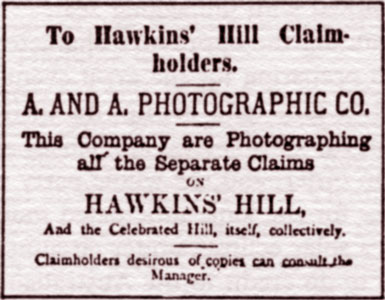
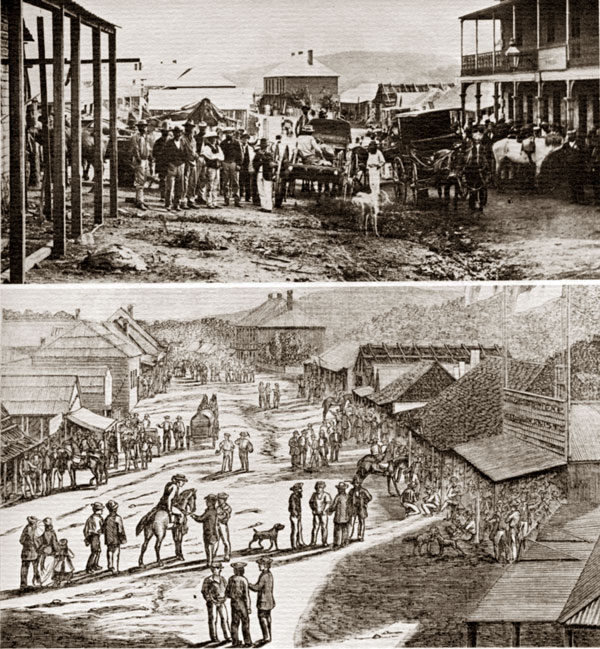
Clarke Street, Hill End. Merlin's photograph of a Saturday afternoon outside Coyle's Hotel includes the coating caravan. (70133) Same scene was the basis for a woodcut which appeared in the Australian Town and Country journal, 30 March 1872.
As suggested earlier, Beaufoy Merlin was not working single-handed and this fact is confirmed by internal evidence in a number of the photographs.
There was his assistant, Charles Bayliss; the driver of the coating caravan who also helped with the plate-sensitising. He is usually seen nearby holding a spare dark-slide; and a third hand, whose duties probably combined studio camera operating with miscellaneous dark room jobs such as floating, cutting and printing the albumen paper which came in large sheets.
Footnotes
-
However, it would seem that Merlin later returned to England for a period; according to Merlin's death certificate, in 1863, at the age of thirty-three, he married Louisa Elliott Foster and this ceremony is recorded as having taken place in London. After his death, Merlin's widow returned to England with the children and later established one of the world's first organised training schemes for female telephone switchboard operators. There were four children of the marriage: Mary Beaufoy (born c. 1865), believed by the Merlin descendants to have later been on the stage in Canada; Frederick ('Frank') Henry Beaufoy (born Ballarat c. 1867) who some years after his father's death returned to Australia; Constance Beaufoy (born c. 1870), a successful dramatic actress on the London stage; and - Beaufoy (born Hill End 1873) whose other Christian name is not known and who is thought to have died in infancy.
-
It was hoped that this Vice-Regal album of photographs was still extant, but enquiries in England revealed that the major portion of the Manners-Sutton family archives were destroyed during the Second World War.
-
The Expedition, commanded by Lieut. J. Gowland, R.N., left Sydney on 27 November 1871. On board were the official party, which included H. C. Russell, the New South Wales Government Astronomer, several scientists and interested observers, `besides a thoroughly efficient crew, making a total of seventy-two souls'.
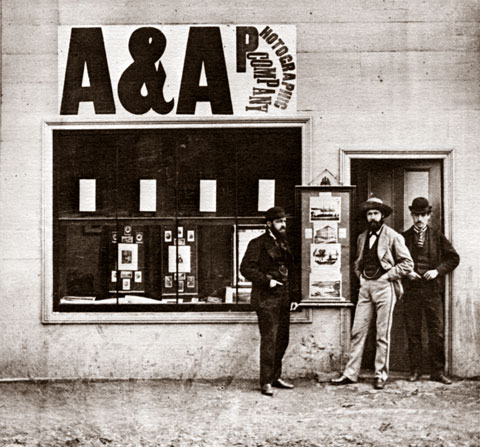
Studios of the American & Australasian Photographic Company, Hill End.
Confident young Charles Bayliss stands in the doorway, behind him is his assistant, on his right the caravan driver.
In the windows can be seen a display of carte-de-visite portraits, and to the left of the doorway are examples of Merlin's 1870 photography of Sydney. (18850)
The A. & A. Photographic Co. remained in Hill End for three months, and visited the Turon River and the older mining settlement of Tambaroora, a few miles away to the north.
But nowhere is there recorded the very important date when Merlin was approached by a well-attired local citizen, his waistcoat adorned by a heavy gold chain carrying a miniature lucky charm - a person whom he had often observed in the streets of Hill End.
The date would have been fairly early, for it is most unlikely that two individuals possessing similar qualities of initiative and driving force could long remain apart. Great events were to arise from the encounter, but the story must wait upon its logical turn.
Meanwhile a studio for the A. & A. Co. was built on a block of ground owned by Holtermann in Tambaroora Street, close to its intersection with Short Street.
It was an historic meeting this - when the gold of Holtermann first came into close association with the silver of Merlin's photographic process.
After three busy months in Hill End, the caravan moved on to Gulgong, several days travel to the north. Assuredly both towns would have made a strong appeal to a man of Beaufoy Merlin's artistic taste and inclinations as any visitor to the areas would confirm today.
Merlin methodically set about his coverage of Gulgong. With his well equipped carte-de-visite caravan, he moved about everywhere and photographed everything. It is certain that no area in the world, and certainly no town within
a matter of months of its foundation, was as thoroughly photographed during this period as was Gulgong.
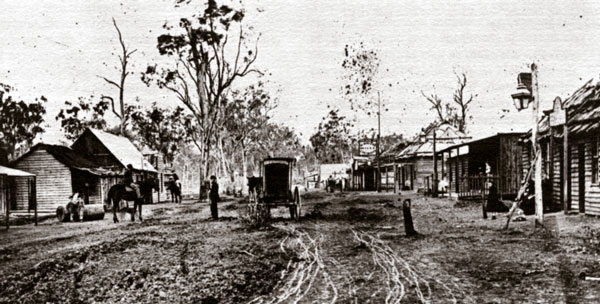
Black Lead, north of Gulgong, 1872.
Merlin is shown on horse-back to the left of the coating caravan; the driver of the caravan is holding a spare wet-plate slide. (18402)
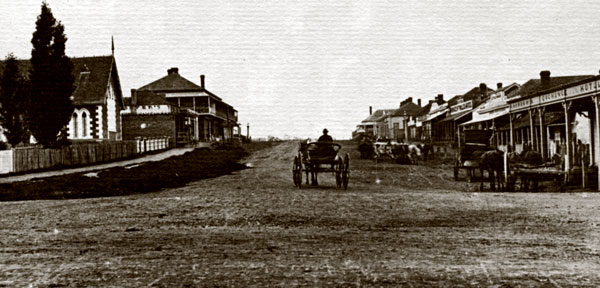 Street scene, Orange; note Merlin's caravan (far right) behind the dray. (126)
Street scene, Orange; note Merlin's caravan (far right) behind the dray. (126)
Merlin photographed all the business premises in the town, every church and every school and almost every house -and in each instance groups of people, be they the principal or the customer or just the regular run of the passers-by, were realistically included in the picture.
Across the span of exactly ten decades we can share the pride of the successful miner with his half-dozen nuggets shining in the tail of his dish; we can observe the official visit of the Clerk of Petty Sessions; we can approve the pride of Father O'Donovan in his neat new church.
We are introduced to the newspaper men outside their offices, the medicos beside the pharmacies, the hotel-keepers and their wives, the bakers and the butchers.
Gulgong lent itself to this field of photography much better than Hill End, but by early October the market had been exhausted and the team returned to Hill End, there to continue its regular house-by-house programme.
During the comparatively short time that Merlin had been away, Hill End had developed considerably and the new series of illustrations provided some valuable comparisons with the earlier ones. He was in Hill End on that never-to-be-forgotten Saturday, i9 October, when Holtermann's great specimen was brought to the surface - and carefully photographed.
In December 1872 he moved on to Bathurst and he was in this town when he learnt that he had been officially appointed `Photographic Artist of the Holtermann Exposition', an outline of which undertaking was given in the previous chapter.
On his trip to the central west, he was not satisfied merely to take a very large number of photographs but also made time to describe his travels. These articles are of considerable length and combine descriptions of the landscape with entertaining sidelights of the journey.
They were printed in three issues of the Australian Town and Country Journal, of 19 April, 5 July and 27 September 1873. A few extracts from the initial article should suffice to give the reader an impression of Merlin's ability as a writer.
'When I arrived in Orange, at 7.30 p.m., the place was all alive and aglow. Grocers' shops and butchers' stalls shone brilliantly amid the umbrageous decorations and floral wreaths, while numbers of well-dressed people -the ladies particularly -gave commotion to the scene.
In fact, it was Christmas Eve, and gaily did the Orange men and women celebrate it!
The weather being fine, and the streets less rutty and irregular than in many other colonial towns I wot of, it was impossible not to enjoy a stroll through the principal thoroughfare.
The principal stores were particularly brilliant and busy on the occasion referred to, while the graceful facade of [the] Commercial Bank, relieved by its "shady lustre", to quote a phrase of Milton's, the excess of radiance around. Branches or saplings of gum-tree made a bad Christmas substitute for the old English holly.
Surely something better than dingy grey might be got to remind us of dark green. Notwithstanding the dull character of the foliage, the shops presented a really pretty appearance, and kept many a flaneur gazing at them till midnight ...
`If there were no chimes, no predatory waifs, no blithe revellers - to welcome in King Christmas, after the fashion of the old-world countries, there were "genial revellers a few" in Orange to celebrate the event; and I think the first flush of day must have warmed the ear before the last echoes of hilarity died away.
`When I first put in an appearance at breakfast next morning, I found myself vis-a-vis my landlord only. Everybody had gone away, some to visit country friends, others on picnic excursions, and I presume some to church.
Everything was still and in oppressive contrast with the excitement of the preceding evening.
Now, my host of the "Commercial", certainly as jolly kind-hearted a fellow as ever I met, was, through his tremendous Christmas Eve exertions hardly "up to the mark".
Performances at the public bar for twenty hours on the stretch, are not conducive to sprightliness of conversation. Our tete-a-tete was not therefore at breakfast animated, nor was a stroll along the deserted and dusty streets very lively afterwards.
It was singular with what unamity of purpose the people had deserted the town. I had, however, a good opportunity of noticing its cheerful position and growing importance.
In the principal street there are indications at once of wealth and taste. The district around Orange is very fertile, and signs of agricultural progress are everywhere apparent. Some good specimens of cereals and other products, as well as minerals, will attest the resources of this locality in Holtermann's exhibition.'
It is believed that the 10" by 12" section of the Collection includes all of the negatives taken during the tour of central western New South Wales and provides records of Bathurst, Rockley, Orange, Dubbo, Trunkey, Carcoar, Goulburn and some unidentified places -the latter group apparently made on the return trip.
When Merlin came back to Sydney in late July or early August, he soon became more than ever convinced of the need of the colony for a 'Holtermann Exposition' to travel abroad. This was when he read, in the columns of the Melbourne Argus for 26 July 1873, an account of the current Vienna International Exhibition. It was a magnificent affair set in 450 acres of wooded parkland beside the Danube, but `New South Wales is lamentably conspicuous by her absence, and such apathy is very much to be regretted, for an Exhibition like this ... where all the world is, so to speak, on its trial; not to be there is to argue yourself unknown.'
Meanwhile there was his photographic coverage of Sydney to be attended to - which was duly done, two hundred 10" by 12" negatives being obtained.
It was intended, according to the Sydney Mail for 2 August, that the Exposition should include 'well-executed photographic views of every town in all these colonies ... with the more elaborate views to be glass transparencies, enlarged from the originals and vividly coloured. In the same section, there are also to be large-sized albums of each town, with other ready means of information.'
When the weather was unsuitable for the obtaining of `pleasing views of the environs of Sydney', he wrote an article for the Town & Country Journal, on the matter of the New South Wales failure at Vienna.
`Not only have the Victorians made themselves famous to our depreciation, but even the Queenslanders are imitating the example of the latter. It certainly needed a man of energy and means, a man of practical experience and undaunted spirit, in a word, a man like Holtermann, to stir up the stagnant waters of public apathy and infuse a little go-ahead-ism into this community.
Why should we not display the country's resources in conspicuous places, show to the over-crowded nations of Europe what a fine field there is here for honest labour and the investment of capital?
It pains one to note the listlessness with which people hear about an exhibition, in which varied specimens of the country's mineral treasures, of her unrivalled timber, of her infant industries will be brought together, and made clear to all who take the trouble of opening their eyes.
On social, commercial, and political grounds it is the bounden duty of the people of New South Wales to prove to the world that she has within her territory the material of future greatness; and it is to be hoped all men of true patriotic spirit in the colony will cooperate with Mr Holtermann in demonstrating on a large scale the country's wealth, and its attractiveness as a scene of industrial operations.
I cannot, up to the present time, boast of much sympathy on the part of the community with Mr Holtermann's comprehensive scheme; but I have reason to think when its extent, and the more obvious results likely to arise from it, become better known, the people generally will appreciate what is being done for them.
How much more telling will the exhibition of the country's resources be when displayed in every country town of the United Kingdom and principal cities of Europe, than mere statistical statements, Agent-generals' letters, or the speeches of paid lecturers.
I firmly believe that thousands will yet be attracted hither by the Holtermann display, who would not otherwise leave the old world, or if they did, would seek a new home in the United States of America.'
This was Merlin's last public act : the next issue of the Journal, 4 October 1873, carried his obituary:
`The numerous friends of Mr Beaufoy Merlin throughout the colony will learn with deep regret that he died after a very short illness on Saturday afternoon [27 September] of inflammation of the lungs supervening upon the epidemic (a kind of influenza) which has lately been so general in Sydney.
Mr Merlin won the esteem of a wide circle of friends by his great kindness of heart, and singularly unpretentious, straightforward and general character. Energetic, temperate, and active to a remarkable degree, his unexpected decease will surprise as well as grieve all to whom he was known. As a photographic artist he was almost without a rival, while his talents as a writer were of a very superior kind, although want of leisure greatly interfered with his literary tastes.'
Merlin died at his home, Abercrombie House, a two-storey building in Holterman's [sic] Terrace, 105 — 118 Little Abercrombie Street, Leichhardt, where a medical practitioner had been treating him for five days for pneumonia.
Beaufoy Merlin had been betrayed by his great love; the wet-plate process called for fixation by means of the deadly potassium cyanide in the closely-confined quarters of a coating caravan.
Almost thirty years of continuous inhalation could not but threaten the lungs of the strongest man. Merlin was buried on 30 September 1873 in the Church of England cemetery at Balmain, today the site of a Pioneers' Memorial Park, near to the Leichhardt Town Hall.
Merlin would have been deeply depressed at the end by the feeling that there was so much more that he wanted to do and could have done.
He would have hoped that sufficient had been completed to provide a sound basis for the travelling exhibition. He would have felt sure that his work would achieve its intended object when displayed overseas.
But he could not have known that, a century later, modern methods would make possible magnificent enlargements - five times larger for general gallery purposes, ten times larger for the selection of individual groups, thirty times larger for the study of notices or handbills.
Australia must forever owe a deep debt of gratitude to Beaufoy Merlin, for his photography proved to be the true historian of that time and place-incomparable, authentic, unchallengeable.
continues: Bayliss
Introduction / Processes / Holtermann / Merlin / Bayliss / Iconography / the Plates / Bibliography
>> see also A. P-R. 1953
The text and notes to the plates: copyright © Keast Burke 1973
The original GOLD AND SILVER plates were taken from the Holtermann negatives, Mitchell Library Sydney